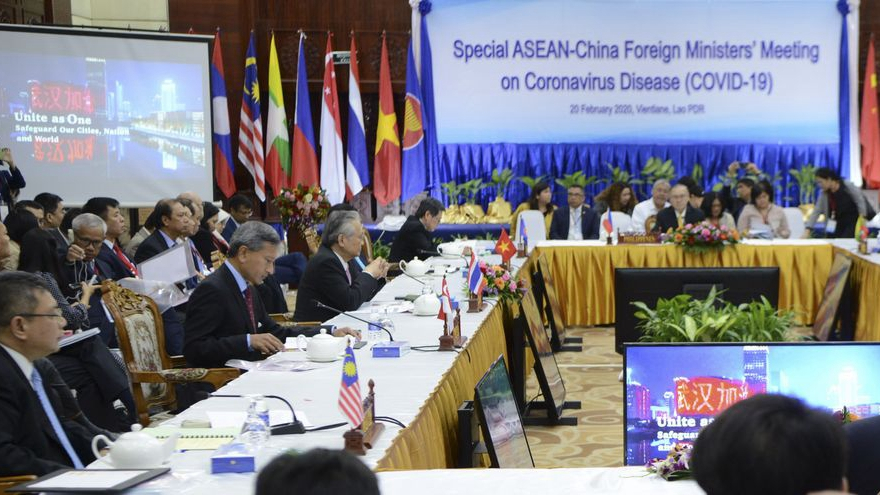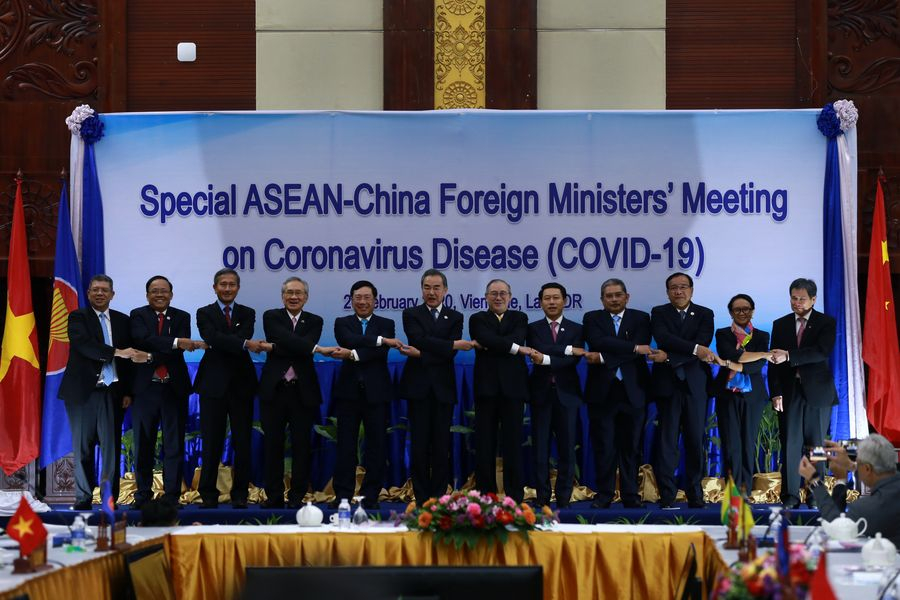
Editor's note: Ji Xianbai, PhD, is a research fellow with the International Political Economy Program of S. Rajaratnam School of International Studies, Nanyang Technological University, Singapore. The article reflects the author's opinions, and not necessarily the views of CGTN.
Amid the global flight against the novel coronavirus, foreign ministers from China and the ten members of the Association of Southeast Asian nations (ASEAN) held a special emergency meeting in the Laotian capital of Vientiane on Thursday. It was the first multilateral ministerial in East Asia that sought to coordinate collective regional efforts to contain the spread of the infectious disease that has killed over 2,100 people globally.
The meeting kicked off with a remarkable show of solidarity. When foreign ministers joined hands on the stage for a photo session at the start of the meeting, the crowd burst out "Stay strong, Wuhan! Stay strong, China! Stay strong, ASEAN!" A short video showing warm words from Southeast Asian leaders like the Singaporean Prime Minister Lee Hsien Loong and Thai Prime Minister Prayut Chan-o-cha was also screened and loudly applauded by the audience.
At the meeting, Chinese Foreign Minister Wang Yi reassured his ASEAN counterparts that the COVID-19 outbreak in China is under firm control, the number of new cases is dropping steadily, and China is willing to share information with Southeast Asian countries on a timely basis. A proposal for the establishment of a China-ASEAN infectious disease liaison mechanism was also floated.
Since the onset of the pandemic, all ASEAN member states except Cambodia have taken tough prevention and control measures, imposing travel bans and visa restrictions and cutting back direct flights with China. As the situation improves in China, Wang Yi particularly lobbied for an early resumption of people-to-people ties and transport connections to stimulate the economy.

Chinese State Councilor and Foreign Minister Wang Yi (L6) and foreign ministers of ASEAN countries attend the Special ASEAN-China Foreign Ministers' Meeting on Coronavirus Disease in Vientiane, Laos, Feb. 20, 2020. /Xinhua
Chinese State Councilor and Foreign Minister Wang Yi (L6) and foreign ministers of ASEAN countries attend the Special ASEAN-China Foreign Ministers' Meeting on Coronavirus Disease in Vientiane, Laos, Feb. 20, 2020. /Xinhua
ASEAN is China's second largest trading partner. China is ASEAN's largest trading partner and a prominent source of foreign direct investment and project financing. This goes without saying that China and ASEAN, having been embedded in extensive regional supply chains, are highly interdependent economically and logistically. It is fair to say that when one side sneezes, the other will catch a cold.
The COVID-19 outbreak and the resulting disruptions are already taking a toll on regional economic growth. For example, Singapore has revised down its economic forecast to -0.5 percent to 1.5 percent, meaning in 2020 the region's most prosperous city-state may go into an economic contraction due to COVID-19. Several textile factories in Cambodia have ceased operations due to the delay in the supply of raw materials from China. Also, Southeast Asia's tourism industry has taken a hard hit of billions in lost business from Chinese tourists (who are the region's top foreign visitors).
While orderly resuming connections is in the best interest of both China and ASEAN, it can only be done when the COVID-19 is decisively overcome. The situation in China might have been steadily improving since mid-February, but the risk of widespread infection and community transmission in Southeast Asian countries – some of which are not well-equipped with advanced medical facilities and specialized health workers – cannot be ruled out for now.
As of February 20th, Singapore has 85 confirmed cases of COVID-19 infection, the third highest in the world excluding China. Thailand, Malaysia, Vietnam, the Philippines, and Cambodia have combined confirmed cases topping 77. Vietnam has quarantined an area of more than 10,000 residents near Hanoi. The docking of MS Westerdam cruise ship in Sihanoukville could increase Cambodians' risk of contraction as a former passenger on board was tested positive for COVID -19 in Malaysia. Contact-tracing is on-going to track those who had also left the ship. Some virus-carriers might be walking around Cambodia. This is disturbing as even Cambodian Prime Minister Hu Sen was unmasked when greeting the disembarking passengers from the ship.
Brunei, Laos, Myanmar, and Indonesia have yet to report any confirmed cases of COVID -19 infection. Still, there is no room for complacency. In fact, chances are the perceived coronavirus-free situation is because of poor screening. It was not until recently that Indonesia had specific detection kits for confirming the new type of coronavirus. The detection, containment, and treatment capabilities in poorer countries like Laos and Myanmar are much more inadequate. If the deadly COVID -19 viruses circulate among their populations, the consequences could be unimaginably dire. A regional response would surely be called for.
The special China-ASEAN meeting on COVID -19 is indeed a show of solidarity, telling the world that China and ASEAN are on the same page when it comes to addressing a common public health crisis. But it is also an opportunity to raise the awareness about the virus and to step up precautionary measures in countries that have not reported confirmed cases. COVID -19 knows no national borders – the region is safe when every country is genuinely coronavirus-free.
(If you want to contribute and have specific expertise, please contact us at opinions@cgtn.com.)